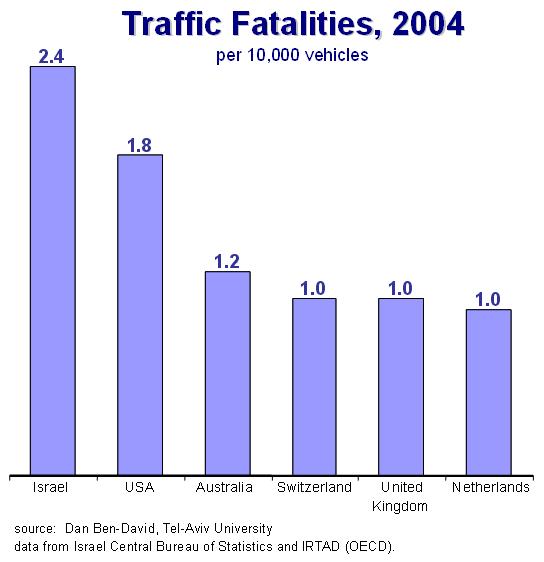|
PDF file
published
in Haaretz on January 16, 2007.
The High-Risk Roads of Israel
by Dan Ben-David and Avi Naor When it comes to traffic accidents, the
common attitude among drivers as they enter their vehicles is “it won’t happen
to me”. The statistics would appear to
support this belief. After all, the
probability of becoming a casualty on any given trip is close to zero, so who
cannot understand the feeling of complacency that engulfs individuals as they
sit behind the wheel or walk across the street?
The issue of traffic safety barely flickers, if at all, on the personal
radar screens. However, if one takes a step back and
looks at the data from a different perspective, the probability picture darkens
considerably. According to Israel’s
Central Bureau of Statistics, roughly 8,000 people were killed and over 600,000
were injured, more than 50,000 of these severely, on Israel’s roads during the
years 1990-2005 – all this out of an average population of less than 6 million
during this period. If these statistics
will also characterize Israel in the future, then the probability that a person
has of getting injured or killed in a traffic accident during the next decade
and a half is 11%. To illustrate what this implies for a
family of five, the probability that at least one of the family members will
become a casualty – and not just involved – in a traffic accident is 43%. The probability that one of the five family
members will be killed in an accident during the next 16 years is close to one
percent. These are no longer trivial
odds. When one considers the extended
family, then there is hardly a family in Israel that will not suffer a casualty
from traffic accidents during the next decade and a half. These statistics are not part of some
pre-determined fate nor are they representative of many other countries. As is indicated in the graph, the number of
fatalities per 10,000 vehicles in Israel is greater than in the United States
by one-third. It is twice the Australian
level and 2.4 times greater than in the Netherlands and in other countries. What do these numbers mean? Had we lowered the number of traffic
fatalities in 2005 to the level of the Netherlands, the lives of 266 people (60%
of the 448 who died) would have been spared.
Just think how many lives could have been spared over the last decade
and a half. This could have been a
completely different country. How can we lower the number of traffic
fatalities? First, it is possible – and
necessary – to remove many people from the roads by building fast, available
and cheap mass transportation systems. This
is important also from the perspective of improving efficiency in the economy, lowering
production costs and increasing output – with all of the positive implications
that this has on raising living standards and reducing income disparity. When the focus turns to the risk associated
with actual travel on the roads – that is, the number of fatalities per
kilometer-traveled – the situation in Israel continues to look bad in
comparison with other countries: 28% more fatalities than in the U.S., 50% more
than in Australia and Switzerland, 56% more than the Netherlands, and 58% more
than in the U.K. There is considerable
room for improvement. According to one of the leading
researchers in this field, Prof. Ian Johnston, we need to “put five star people
in five star cars on five star roads.”
In other words, traffic safety education is critical, but it is only one
variable in the equation. It is also
important to switch to new vehicles that are designed and built to provide
greater safety. And the third variable, infrastructure, plays a decisive role
in completing the picture. Despite the frequent inclination to
place responsibility for an accident on the “human factor,” the time has come
to redefine what this term actually means.
When narrow road shoulders are constructed, when poles and trees are
placed in close proximity to traffic, when sharp curves are built on intercity
roads, when road markings are inadequate and misleading, when there is no
serious enforcement of laws against the most dangerous traffic violations, then
this is a “human factor” that must be addressed. Hopefully, the new National Traffic Safety
Authority that is now being created will know how to identify and influence the
entire human factor issue in a much more effective manner than we have been
familiar with in the past. Dan Ben-David
teaches economics in the Department of Public Policy in Tel-Aviv University. Avi Naor is the founder and chairman of the
Or Yarok Association. comments
to:
danib@post.tau.ac.il
|
